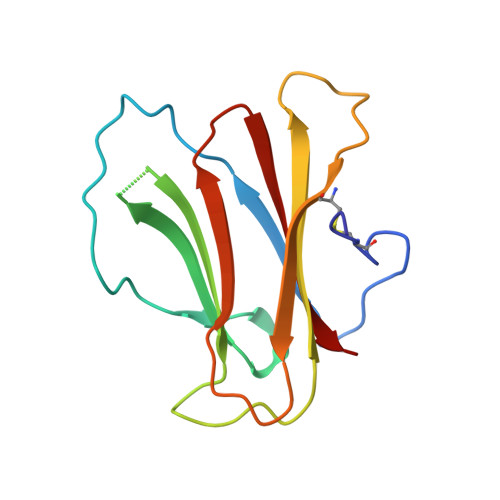Structure-function analysis of the Fusarium oxysporum Avr2 effector allows uncoupling of its immune-suppressing activity from recognition.
Di, X., Cao, L., Hughes, R.K., Tintor, N., Banfield, M.J., Takken, F.L.W.(2017) New Phytol 216: 897-914
- PubMed: 28857169
- DOI: https://doi.org/10.1111/nph.14733
- Primary Citation of Related Structures:
5OD4 - PubMed Abstract:
Plant pathogens employ effector proteins to manipulate their hosts. Fusarium oxysporum f. sp. lycopersici (Fol), the causal agent of tomato wilt disease, produces effector protein Avr2. Besides being a virulence factor, Avr2 triggers immunity in I-2 carrying tomato (Solanum lycopersicum). Fol strains that evade I-2 recognition carry point mutations in Avr2 (e.g. Avr2 R45H ), but retain full virulence. Here we investigate the virulence function of Avr2 and determine its crystal structure. Transgenic tomato and Arabidopsis expressing either wild-type ΔspAvr2 (deleted signal-peptide) or the ΔspAvr2 R45H variant become hypersusceptible to fungal, and even bacterial infections, suggesting that Avr2 targets a conserved defense mechanism. Indeed, Avr2 transgenic plants are attenuated in immunity-related readouts, including flg22-induced growth inhibition, ROS production and callose deposition. The crystal structure of Avr2 reveals that the protein shares intriguing structural similarity to ToxA from the wheat pathogen Pyrenophora tritici-repentis and to TRAF proteins. The I-2 resistance-breaking Avr2 V41M , Avr2 R45H and Avr2 R46P variants cluster on a surface-presented loop. Structure-guided mutagenesis enabled uncoupling of virulence from I-2-mediated recognition. We conclude that I-2-mediated recognition is not based on monitoring Avr2 virulence activity, which includes suppression of immune responses via an evolutionarily conserved effector target, but by recognition of a distinct epitope.
Organizational Affiliation:
Molecular Plant Pathology, SILS, University of Amsterdam, PO Box 94215, 1090 GE, Amsterdam, the Netherlands.















